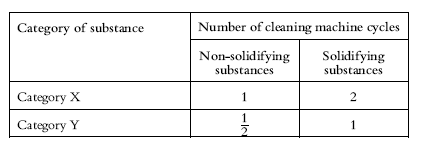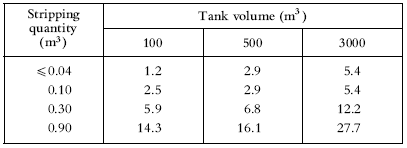|
||||||||||||||||||||
|
||||||||||||||||||||
| Appendix 6 Prewash Procedures |
||||||||||||||||||||
|
A For ships built before 1 July 1994 A prewash procedure is required in order to meet certain Annex II requirements. This appendix explains how these prewash procedures shall be performed.
1 Tanks shall be washed by means of a rotary water jet, operated at sufficiently high water pressure. In the case of category X substances, cleaning machines shall be operated in such locations that all tank surfaces are washed. In the case of category Y substances, only one location need be used. 2 During washing, the amount of water in the tank shall be minimized by continuously pumping out slops and promoting flow to the suction point (positive list and trim). If this condition cannot be met, the washing procedure shall be repeated three times, with thorough stripping of the tank between washings. 3 Those substances which have a viscosity equal to or greater than 50 mPa·s at 20°C shall be washed with hot water (temperature at least 60°C), unless the properties of such substances make the washing less effective. 4 The number of cycles of the cleaning machine used shall not be less than that specified in table 6-1. A cleaning machine cycle is defined as the period between two consecutive identical orientations of the tank cleaning machine (rotation through 360°). 5 After washing, the tank cleaning machine(s) shall be kept operating long enough to flush the pipeline, pump and filter, and discharge to shore reception facilities shall be continued until the tank is empty. Prewash procedures for solidifying substances 1 Tanks shall be washed as soon as possible after unloading. If possible, tanks shall be heated prior to washing. 2 Residues in hatches and manholes shall preferably be removed prior to the prewash. 3 Tanks shall be washed by means of a rotary water jet operated at sufficiently high water pressure and in locations to ensure that all tank surfaces are washed. 4 During washing, the amount of water in the tank shall be minimized by pumping out slops continuously and promoting flow to the suction point (positive list and trim). If this condition cannot be met, the washing procedure shall be repeated three times with thorough stripping of the tank between washings. 5 Tanks shall be washed with hot water (temperature at least 60°C) unless the properties of such substances make the washing less effective. 6 The number of cycles of the cleaning machine used shall not be less than that specified in table 6-1. A cleaning machine cycle is defined as the period between two consecutive identical orientations of the machine (rotation through 360°). 7 After washing, the cleaning machine(s) shall be kept operating long enough to flush the pipeline, pump and filter, and discharge to shore reception facilities shall be continued until the tank is empty. Table 6-1 – Number of cleaning machine cycles to be used in each location
A prewash procedure is required in order to meet certain Annex II requirements. This appendix explains how these prewash procedures shall be performed and how the minimum volumes of washing media to be used shall be determined. Smaller volumes of washing media may be used based on actual verification testing to the satisfaction of the Administration. Where reduced volumes are approved, an entry to that effect must be recorded in the Manual. If a medium other than water is used for the prewash, the provisions of regulation 13.5.1 apply. Prewash procedures for non-solidifying substances without recycling 1 Tanks shall be washed by means of a rotary jet(s), operated at sufficiently high water pressure. In the case of category X substances, cleaning machines shall be operated in such locations that all tank surfaces are washed. In the case of category Y substances, only one location need be used. 2 During washing, the amount of liquid in the tank shall be minimized by continuously pumping out slops and promoting flow to the suction point. If this condition cannot be met, the washing procedure shall be repeated three times, with thorough stripping of the tank between washings. 3 Those substances which have a viscosity equal to or greater than 50 mPa·s at 20°C shall be washed with hot water (temperature at least 60°C), unless the properties of such substances make the washing less effective. 4 The quantities of wash water used shall not be less than those specified in paragraph 20 or determined according to paragraph 21. 5 After prewashing, the tanks and lines shall be thoroughly stripped. Prewash procedures for solidifying substances without recycling 6 Tanks shall be washed as soon as possible after unloading. If possible, tanks should be heated prior to washing. 7 Residues in hatches and manholes should preferably be removed prior to the prewash. 8 Tanks shall be washed by means of a rotary jet(s) operated at sufficiently high water pressure and in locations to ensure that all tank surfaces are washed. 9 During washing, the amount of liquid in the tank shall be minimized by pumping out slops continuously and promoting flow to the suction point. If this condition cannot be met, the washing procedure shall be repeated three times with thorough stripping of the tank between washings. 10 Tanks shall be washed with hot water (temperature at least 60°C), unless the properties of such substances make the washing less effective. 11 The quantities of wash water used shall not be less than those specified in paragraph 20 or determined according to paragraph 21. 12 After prewashing, the tanks and lines shall be thoroughly stripped. Prewash procedures with recycling of washing medium 13 Washing with a recycled washing medium may be adopted for the purpose of washing more than one cargo tank. In determining the quantity, due regard must be given to the expected amount of residues in the tanks and the properties of the washing medium and whether any initial rinse or flushing is employed. Unless sufficient data are provided, the calculated end concentration of cargo residues in the washing medium shall not exceed 5% based on nominal stripping quantities. 14 The recycled washing medium shall only be used for washing tanks having contained the same or similar substance. 15 A quantity of washing medium sufficient to allow continuous washing shall be added to the tank or tanks to be washed. 16 All tank surfaces shall be washed by means of a rotary jet(s) operated at sufficiently high pressure. The recycling of the washing medium may either be within the tank to be washed or via another tank, e.g. a slop tank. 17 The washing shall be continued until the accumulated throughput is not less than that corresponding to the relevant quantities given in paragraph 20 or determined according to paragraph 21. 18 Solidifying substances and substances with a viscosity equal to or greater than 50 mPa·s at 20°C shall be washed with hot water (temperature at least 60°C) when water is used as the washing medium, unless the properties of such substances make the washing less effective. 19 After completing the tank washing with recycling to the extent specified in paragraph 17, the washing medium shall be discharged and the tank thoroughly stripped. Thereafter, the tank shall be subjected to a rinse, using clean washing medium, with continuous drainage and discharged to a reception facility. The rinse shall as a minimum cover the tank bottom and be sufficient to flush the pipelines, pump and filter. Minimum quantity of water to be used in a prewash 20 The minimum quantity of water to be used in a prewash is determined by the residual quantity of noxious liquid substance in the tank, the tank size, the cargo properties, the permitted concentration in any subsequent wash water effluent, and the area of operation. The minimum quantity is given by the following formula: where
For category X substances the value of r shall either be determined based on stripping tests according to the Manual, observing the lower limits as given above, or be taken to be 0.9 m3.
The table below is calculated using the formula with a k factor of 1 and may be used as an easy reference.
21 Verification testing for approval of prewash volumes lower than those given in paragraph 20 may be carried out to the satisfaction of the Administration to prove that the requirements of regulation 13 are met, taking into account the substances the ship is certified to carry. The prewash volume so verified shall be adjusted for other prewash conditions by application of the factor k as defined in paragraph 20. |

